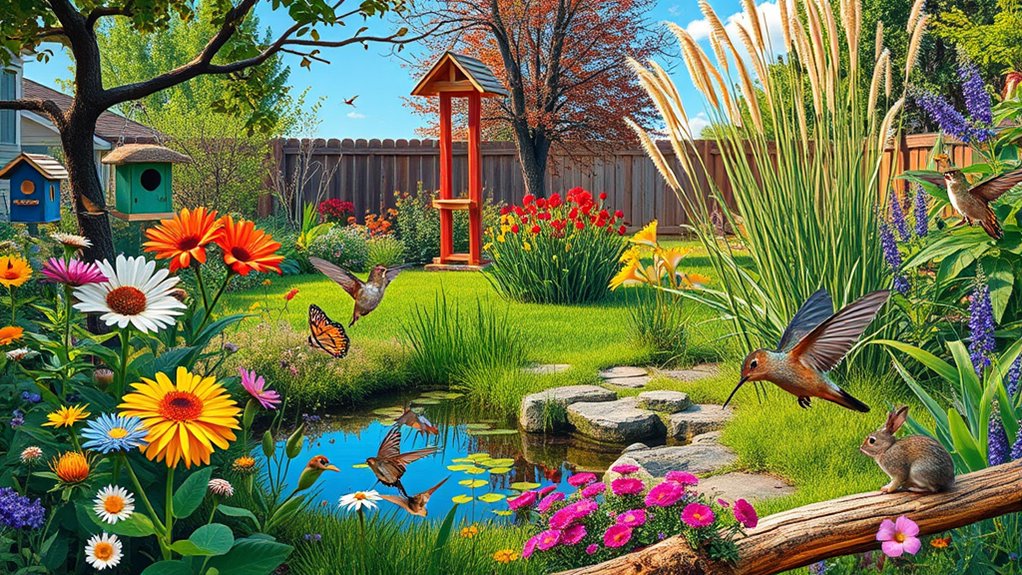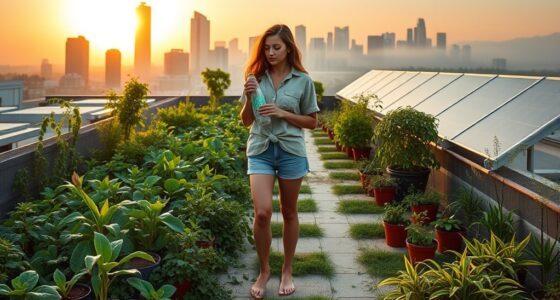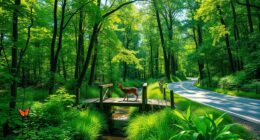To turn your garden into a wildlife haven, start by planting native plants that attract pollinators and provide food and shelter. Add water features like ponds or birdbaths to supply essential hydration. Create shelter with brush piles, birdhouses, or leaving some areas wild. Use organic gardening practices to keep the environment safe. Incorporating these elements helps support local ecosystems and increases biodiversity—discover more tips for creating your ideal wildlife-friendly space.
Key Takeaways
- Plant native species to create a resilient and resource-efficient habitat that attracts local pollinators and wildlife.
- Add water features like ponds or birdbaths to provide essential hydration and attract diverse species.
- Incorporate shelter options such as birdhouses, brush piles, and leaving some areas wild for nesting and predator protection.
- Minimize lawn size and avoid pesticides to promote organic gardening and support beneficial insects and birds.
- Design your garden to mimic natural habitats, fostering biodiversity and creating a sustainable, wildlife-friendly environment.

Have you ever considered how your backyard can become a pivotal refuge for local wildlife and a step toward environmental sustainability? By making simple yet impactful changes, you can transform your outdoor space into a vibrant habitat that supports birds, insects, and other creatures. One of the most effective ways to do this is by planting native plants. These plants are adapted to your region’s climate and soil, making them more resilient and easier to maintain. Native plants also provide essential food sources like nectar, seeds, and berries, attracting pollinators such as bees, butterflies, and hummingbirds. When you choose native species for your garden, you’re creating a sustainable ecosystem that requires fewer resources, like water and fertilizers, reducing your environmental footprint.
In addition to native plants, incorporating water features can greatly boost your backyard’s appeal to wildlife. A pond, birdbath, or small fountain creates a critical source of water, especially during dry periods. Water is essential for many species, from insects to mammals, and having a consistent supply encourages them to visit your yard regularly. Moving water, like a fountain or dripping feature, also attracts birds and insects, providing both hydration and a place to hunt or rest. When you design your water feature, consider adding aquatic plants and rocks to mimic natural habitats, making it more inviting for wildlife. Clean, shallow water sources are best, as they are safe and accessible for a variety of species.
Creating a wildlife-friendly backyard doesn’t stop at plants and water. You should also think about providing shelter and nesting sites. Leaving some areas wild or adding birdhouses and brush piles can offer safe spaces for nesting and hiding from predators. Avoid using pesticides or chemicals, as these can harm beneficial insects and birds. Instead, focus on organic gardening practices that promote a healthy, balanced ecosystem. By reducing lawn size and replacing it with native plants, you also minimize water usage and maintenance efforts, allowing more time for observing wildlife and enjoying your transformed yard.
Frequently Asked Questions
What Native Plants Attract the Most Wildlife?
When choosing native plants, you want to focus on native plant selection that attracts wildlife and promotes habitat diversity. Plants like milkweed, coneflowers, and goldenrod are especially effective, providing food and shelter for pollinators, birds, and insects. By incorporating a variety of these native species, you create a thriving ecosystem that supports local wildlife, making your garden a vibrant, bustling habitat that benefits both you and nature.
How Can I Reduce Garden Chemical Use Safely?
Think of your garden as a delicate symphony—each note matters. To reduce chemical use safely, switch to organic fertilizers that nourish plants naturally, and embrace pest control methods like beneficial insects or homemade remedies. Avoid harsh chemicals, and monitor your garden regularly to catch problems early. This approach keeps your ecosystem balanced, ensuring a healthier garden for both wildlife and your family, creating harmony without disruption.
Which Bird Species Are Most Common in Small Gardens?
In small gardens, you’ll most often see sparrows, finches, and chickadees. To attract them, place your bird feeder in a safe spot away from predators and keep it clean. Use different nest box types, like cavity or open-front, to suit various species. Regularly monitor and maintain your feeders and nest boxes, ensuring your garden becomes a welcoming habitat that draws these common birds naturally.
How Do I Create a Bug-Friendly Habitat?
To create a bug-friendly habitat, you should provide a variety of native plants and avoid pesticides, which harm beneficial insects. Incorporate bug hotels and leave some leaf litter to offer shelter. These steps attract beneficial insects that naturally control pests, reducing the need for chemical pest control. By supporting these insects, you promote a healthy garden ecosystem where pests are naturally managed, making your garden more vibrant and sustainable.
What Are Eco-Friendly Ways to Water My Garden?
You can water your garden eco-friendly by using rainwater harvesting, which captures rain for later use, reducing your reliance on tap water. Incorporate drip irrigation to deliver water directly to plant roots efficiently, minimizing waste and evaporation. These methods conserve water, lower your utility bills, and help protect the environment. By choosing sustainable watering practices like rainwater harvesting and drip irrigation, you support a healthier garden and a greener planet.
Conclusion
By transforming your garden into a wildlife haven, you’re planting seeds of hope that bloom into thriving ecosystems. Think of your yard as a vibrant mosaic, each small change adding color and life to the bigger picture. With a little effort, your backyard becomes a sanctuary where nature can flourish, echoing the beauty of a wildflower meadow. Together, you and your garden can create a lush, living masterpiece that benefits both wildlife and your soul.







